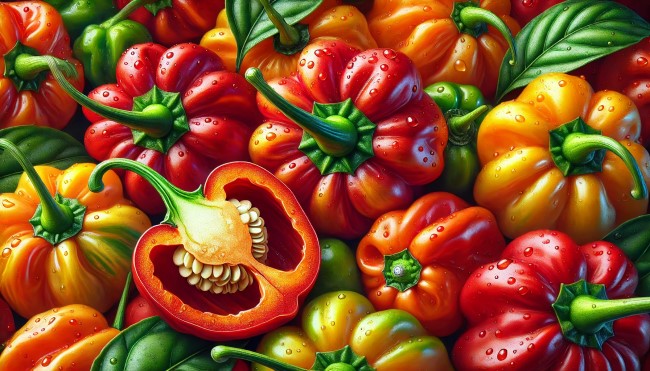Scotch Bonnet pepper: The Fiery Delight of Caribbean Cuisine

The Scotch Bonnet pepper is synonymous with vibrant heat and flavour, particularly in Caribbean cuisine. Known for its potent spiciness and distinct fruity flavour, the Scotch Bonnet chilli stands out in peppers. From jerk chicken to spicy sauces, this pepper adds heat and a unique taste. In this article, we will dive deep into the world of Scotch Bonnet peppers, explore their origins, characteristics, differences from other peppers, and how they can enhance your culinary adventures.
What is a Scotch Bonnet Pepper?
The Scotch Bonnet pepper gets its name from its shape, which resembles a Scottish tam o’ shanter hat. This chilli is native to the Caribbean and is widely used in the region’s cuisine, particularly in Jamaica, Haiti, and Trinidad. With heat ranging between 100,000 and 350,000 Scoville Heat Units (SHU), the Scotch Bonnet pepper packs a significant punch, sitting in the same heat category as its close relative, the habanero.
While the heat is impressive, its distinct flavour profile makes the Scotch Bonnet special. Unlike many other hot peppers that are earthy or smoky, the Scotch Bonnet boasts a fruity sweetness with hints of apple, cherry, and tomato. This combination of heat and sweetness makes it a favourite for hot sauces, marinades, and jerk seasoning.
Scotch Bonnet vs. Habanero: What’s the Difference?
Often confused due to their similar heat levels and appearance, the Scotch Bonnet and habanero peppers are, in fact, distinct. Both peppers originate from the Capsicum chinense species, but there are critical differences in their flavour and culinary applications.
- Heat Level: Both peppers fall within the same Scoville range, but the habanero is often described as slightly spicier, though the difference is minimal.
- Flavour: The most significant difference is in the flavour. While the habanero has a citrusy, slightly bitter taste, the Scotch Bonnet is known for its sweet, fruity undertones. This makes the Scotch Bonnet a preferred choice in Caribbean dishes, where the sweetness complements the heat.
- Shape and Size: Visually, the Scotch Bonnet has a more rounded, squat shape, while the habanero tends to be slightly elongated and pointier at the end.
In summary, while both peppers bring the heat, the Scotch Bonnet’s unique flavour sets it apart, particularly in recipes that benefit from a touch of sweetness.
Culinary Uses of Scotch Bonnet Peppers
Scotch Bonnet peppers are incredibly versatile in the kitchen. They are most famously used in Caribbean dishes, but their use extends far beyond jerk chicken. Here are some popular uses for this fiery chilli:
- Jamaican Jerk: Perhaps the most famous use of Scotch Bonnet peppers is in jerk seasoning, a traditional Jamaican spice blend used to marinate meat, particularly chicken and pork. The pepper’s heat and sweetness add depth to the smoky, grilled flavour of jerk dishes.
- Hot Sauces: Scotch Bonnet peppers are a staple in many Caribbean hot sauces. Their fruity flavour perfectly balances the vinegar and salt often found in hot sauces, creating a spicy and flavorful sauce.
- Curries and Stews: In Caribbean cuisine, Scotch Bonnets add heat and flavour to soups, stews, and curries. A small amount goes a long way, so it’s common to see whole peppers added to these dishes and removed before serving to avoid overwhelming the dish with heat.
- Salsas and Marinades: Scotch Bonnet peppers’ fruity flavour pairs wonderfully with tropical fruits like mango and pineapple, making them a great addition to fresh salsas or fruit-based marinades for fish and chicken.
How to Handle Scotch Bonnet Peppers
As with any hot pepper, handling Scotch Bonnets requires care. Capsaicin, the compound responsible for the pepper’s heat, can cause skin irritation and a burning sensation if it comes into contact with your skin or eyes. Here are a few tips for safely handling Scotch Bonnet peppers:
- Wear Gloves: Always wear gloves when cutting or handling Scotch Bonnet peppers. This prevents the capsaicin from coming into contact with your skin.
- Remove Seeds for Less Heat: The seeds and white membrane inside the pepper contain the highest concentration of capsaicin. To reduce the heat, remove these parts before using the pepper.
- Wash Hands Thoroughly: Even if you’re wearing gloves, washing your hands thoroughly after handling the peppers is essential. Avoid touching your face, particularly your eyes, until you’ve washed your hands.
Health Benefits of Scotch Bonnet Peppers
In addition to their culinary uses, Scotch Bonnet peppers offer a range of health benefits. Capsaicin, the compound that makes peppers spicy, has been shown to have several positive effects on the body:
- Pain Relief: Capsaicin is often used in topical creams to relieve arthritis muscle and nerve pain. It temporarily desensitizes nerve receptors, providing relief from pain.
- Boosts Metabolism: Consuming hot peppers like Scotch Bonnets can increase metabolism and help lose weight. Capsaicin stimulates thermogenesis, the process by which your body burns calories to produce heat.
- Rich in Vitamins: Scotch Bonnet peppers are an excellent source of vitamins A and C. Vitamin A supports eye health and immune function, while vitamin C is essential for healthy skin and a robust immune system.
- Anti-inflammatory Properties: Capsaicin has anti-inflammatory properties, which can help reduce the risk of chronic diseases like heart disease and cancer.
What Are Scotch Bonnet Chillies?
Scotch Bonnet chillies are the same as Scotch Bonnet peppers, a term often used interchangeably depending on the region. In the UK and other parts of the world, the term “chillies” is more commonly used, while in the US, they are referred to as “peppers.”
Growing Scotch Bonnet Peppers
If you’re interested in adding Scotch Bonnets to your garden, the good news is that they are relatively easy to grow in warm climates. Here’s what you need to know:
- Climate: Scotch Bonnet peppers thrive in warm, tropical climates. They require full sun and well-drained soil. They can be grown in pots and moved indoors during colder months in cooler temperatures.
- Watering: These peppers need regular watering, but be careful not to overwater them, as this can lead to root rot. The soil should be kept moist but not soggy.
- Harvesting: Scotch Bonnet peppers can be harvested when they turn bright red, yellow, or orange. The colour indicates ripeness and the development of their signature sweetness.
Preserving Scotch Bonnet Peppers
If you have an abundance of Scotch Bonnet peppers, there are several ways to preserve them for future use:
- Freezing: One of the easiest ways to preserve Scotch Bonnet peppers is to freeze them. Wash and dry the peppers, then place them in a freezer-safe bag. They can be used directly from the freezer in cooked dishes.
- Pickling: Pickling Scotch Bonnets in vinegar and spices is a great way to preserve their heat and flavour. Pickled Scotch Bonnets can be used in sauces, sandwiches, and salads.
- Drying: You can dry Scotch Bonnet peppers by hanging them in a warm, dry place or using a food dehydrator. Once dried, they can be ground into chilli powder or used whole in soups and stews.
Conclusion
In conclusion, the Scotch Bonnet pepper is a versatile and flavorful chilli that brings heat and sweetness to various dishes. It is an excellent choice whether you’re a fan of fiery hot sauces, love Caribbean cuisine, or want to add a new dimension to your cooking. With its unique combination of heat and fruity flavour, it stands out among other hot peppers and offers a range of culinary and health benefits.
Now that you know all about Scotch Bonnet peppers, it’s time to experiment with them in your kitchen. Just remember to handle them with care, and get ready to enjoy the delicious, fiery flavours they bring to your dishes!

